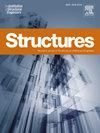Bond behavior between steel bar and coal gangue coarse aggregate concrete: Experimental and numerical investigation
IF 4.3
2区 工程技术
Q1 ENGINEERING, CIVIL
引用次数: 0
Abstract
Using coal gangue (CG) as coarse aggregate in concrete preparation has good economic and environmental benefits, thus the mechanical properties of CG coarse aggregate (CGCA) concrete and the structural performance of reinforced concrete members made of CGCA have been investigated in various studies. However, the research on the bond behavior of ribbed steel bar in CGCA concrete is very limited, which hinders the application of this CGCA concrete. Therefore, in this paper, 36 center pull-out specimens were tested with the parameters of concrete strength grade (C30, C40 and C55), CGCA replacement ratio (0 %, 30 %, 50 %, 70 % and 100 %), and rebar diameter (16 mm and 25 mm). The test results demonstrated that with the increase of CGCA replacement ratio, the failure mode of center pull-out specimen transformed from pull-out failure to splitting failure, and the bond strength decreased by 9.9–50.7 %. Based on the test results presented herein, a prediction model for the bond strength of reinforced CGCA concrete members was proposed and its accuracy was verified. Finally, a meso-scale finite element model of crescent-shaped steel bar and CGCA concrete was established, and its reliability was verified by comparing with the test results in this paper. On this basis, the failure mechanism of crescent-shaped steel bar and CGCA concrete under pull-out force was investigated.
钢筋与煤矸石粗骨料混凝土粘结性能:试验与数值研究
煤矸石粗骨料在混凝土配制中具有良好的经济效益和环境效益,因此对煤矸石粗骨料混凝土的力学性能和用煤矸石粗骨料制成的钢筋混凝土构件的结构性能进行了各种研究。然而,目前对加肋钢筋在CGCA混凝土中的粘结性能的研究非常有限,这阻碍了CGCA混凝土的应用。为此,采用混凝土强度等级(C30、C40、C55)、CGCA替代率(0 %、30 %、50 %、70 %、100 %)、钢筋直径(16 mm、25 mm)等参数对36个中心抽拔试件进行了试验。试验结果表明:随着CGCA替换率的增加,中心抽拔试件的破坏模式由抽拔破坏转变为劈裂破坏,粘结强度下降了9.9 ~ 50.7 %;在试验结果的基础上,提出了钢筋CGCA混凝土构件粘结强度的预测模型,并对模型的准确性进行了验证。最后,建立了月牙形钢筋与CGCA混凝土的细观有限元模型,并与本文试验结果进行对比,验证了模型的可靠性。在此基础上,对月牙形钢筋和CGCA混凝土在拉拔作用下的破坏机理进行了研究。
本文章由计算机程序翻译,如有差异,请以英文原文为准。
求助全文
约1分钟内获得全文
求助全文
来源期刊

Structures
Engineering-Architecture
CiteScore
5.70
自引率
17.10%
发文量
1187
期刊介绍:
Structures aims to publish internationally-leading research across the full breadth of structural engineering. Papers for Structures are particularly welcome in which high-quality research will benefit from wide readership of academics and practitioners such that not only high citation rates but also tangible industrial-related pathways to impact are achieved.
 求助内容:
求助内容: 应助结果提醒方式:
应助结果提醒方式:


